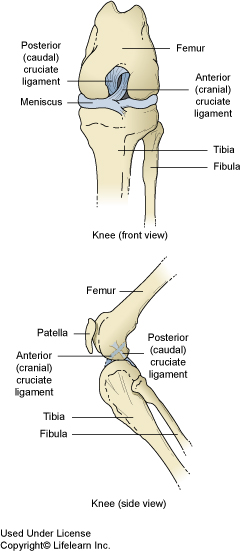
One of our client’s dogs is Bowzer, a 5 year old English Bulldog. Bowzer presented to us recently for lameness in his right hind leg. As I watched him walk into the exam room, I immediately feared this could be a cruciate ligament injury.
One of the most common injuries causing hind limb lameness in dogs is partial or complete rupture of the cruciate ligament. This ligament (often referred to as ‘ACL’ in people) provides stability to the knee joint, keeping the femur bone (above the knee) and the tibia bone (below the knee) anchored to each other during weight bearing.
The ligament weakens in some dogs over time and this leads to a high risk of its rupture. Even normal activities like climbing stairs or hopping out of the car can be enough to cause a weakened ligament to break.
To determine if the ligament has broken, a ‘cranial drawer’ test is performed. To perform this test, the veterinarian holds the femur bone near the knee in one hand and the tibia just below it in the other. Then, the veterinarian attempts to push the tibia forward while holding the femur in place. To reduce muscle tension and pain for the patient during this test, it is often performed while the patient is sedated.
In normal dogs, the cruciate ligament prevents this forward motion in the joint and therefore no movement occurs when force is applied. In dogs with a cruciate ligament rupture, the tibia moves forward because it is not properly secured to the femur. This is called a positive cranial drawer.
Other signs that are consistent with a cruciate ligament tear are swelling in the knee joint, pain on extension of the knee, marked lameness (often the patient will not want to put any weight on the leg), and abnormal sitting posture with the affected leg held out to the side.
Bowzer had significant swelling in his knee and pain when the knee was extended. He was sedated and confirmed to have a positive cranial drawer test. X-rays were taken of the knee, which showed many of the characteristic signs of cruciate ligament rupture.
Treatment for this condition is surgical. Bowzer had surgery this week which changes the architecture of the joint and provides better stability (and much less pain) during regular weight bearing. This is a specialized surgery and we brought in an efficient and experienced orthopedic surgeon to perform the procedure right here at Bucksburn Veterinary Hospital.
The recovery period involves several weeks of restricted activity and physiotherapy, but Bowzer is already walking more comfortably!



